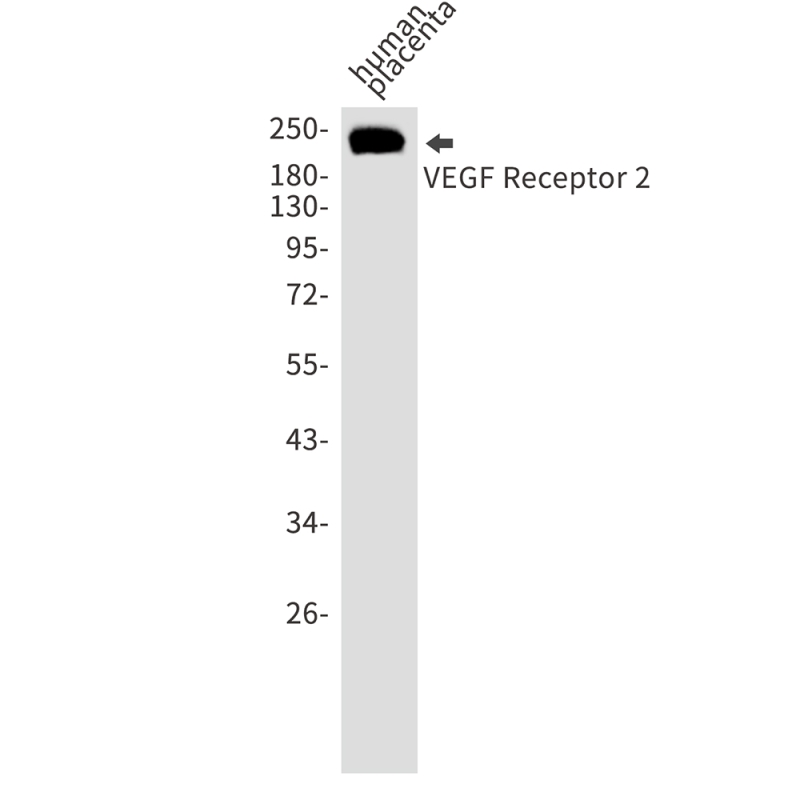
| WB | 1/500-1/1000 | Human,Mouse,Rat |
| IF | 1/20 | Human,Mouse,Rat |
| IHC | 咨询技术 | Human,Mouse,Rat |
| ICC | 技术咨询 | Human,Mouse,Rat |
| FCM | 咨询技术 | Human,Mouse,Rat |
| Elisa | 咨询技术 | Human,Mouse,Rat |
| Aliases | KDR; FLK1; VEGFR2; Vascular endothelial growth factor receptor 2; VEGFR-2; Fetal liver kinase 1; FLK-1; Kinase insert domain receptor; KDR; Protein-tyrosine kinase receptor flk-1; CD antigen CD309 |
| Entrez GeneID | 3791 |
| WB Predicted band size | Calculated MW: 152 kDa; Observed MW: 230,210 kDa |
| Host/Isotype | Rabbit IgG |
| Antibody Type | Primary antibody |
| Storage | Store at 4°C short term. Aliquot and store at -20°C long term. Avoid freeze/thaw cycles. |
| Species Reactivity | Human |
| Immunogen | Recombinant protein of human VEGF Receptor 2 |
| Formulation | Purified antibody in TBS with 0.05% sodium azide,0.05%BSA and 50% glycerol. |
+ +
以下是3篇关于VEGF Receptor 2(VEGFR2)抗体的代表性文献摘要(示例供参考,具体文献请核实数据库):
1. **文献名称**: *Ramucirumab monotherapy for previously treated advanced gastric or gastro-oesophageal junction adenocarcinoma (REGARD): an international, randomised, multicentre, placebo-controlled, phase 3 trial*
**作者**: Fuchs CS et al.
**摘要**: 该III期临床试验证实抗VEGFR2单抗Ramucirumab在晚期胃癌治疗中的有效性,通过阻断VEGFR2信号通路延长患者生存期,为首个获批的靶向VEGFR2抗体药物。
2. **文献名称**: *VEGF-dependent tumor angiogenesis requires inverse and reciprocal regulation of VEGFR1 and VEGFR2*
**作者**: Gerber HP et al.
**摘要**: 研究通过抗VEGFR2抗体的功能阻断实验,揭示了VEGFR2在血管生成中的核心作用,并阐明其与VEGFR1的动态调控机制,为靶向治疗提供理论依据。
3. **文献名称**: *Blocking neuropilin-1 function has an additive effect with anti-VEGF to inhibit tumor growth*
**作者**: Pan Q et al.
**摘要**: 该文献探讨抗VEGFR2抗体与Neuropilin-1抑制剂的联合应用,证明双靶点阻断可更有效抑制肿瘤血管生成,增强抗肿瘤效果。
4. **文献名称**: *Structural basis for VEGF-C binding to VEGFR-2 and biological implications*
**作者**: Leppänen VM et al.
**摘要**: 通过X射线晶体学解析抗VEGFR2抗体与受体结合的结构特征,阐明抗体阻断配体结合的关键表位,为抗体药物设计提供结构生物学基础。
(注:建议通过PubMed/Google Scholar以“VEGFR2 antibody”、“anti-VEGFR2 therapy”等关键词检索最新文献,并优先选择高被引或权威期刊论文。)
Vascular endothelial growth factor receptor 2 (VEGFR2), also known as KDR (kinase insert domain receptor) or Flk-1 (fetal liver kinase 1), is a transmembrane tyrosine kinase receptor primarily expressed on vascular endothelial cells. It plays a central role in angiogenesis and lymphangiogenesis by binding VEGF-A, the key ligand that triggers receptor dimerization, autophosphorylation, and downstream signaling pathways such as PI3K-Akt and MAPK. These pathways regulate endothelial cell proliferation, migration, survival, and vascular permeability. Dysregulation of VEGFR2 is implicated in pathological conditions, including cancer, diabetic retinopathy, and inflammatory diseases, making it a critical therapeutic target.
VEGFR2 antibodies are essential tools for research and clinical applications. Monoclonal or polyclonal antibodies targeting specific extracellular or intracellular domains of VEGFR2 are used to detect receptor _expression (via Western blot, immunohistochemistry, or flow cytometry) or block VEGF-A binding to inhibit signaling. Therapeutic anti-VEGFR2 antibodies, such as ramucirumab, function as receptor antagonists to suppress tumor angiogenesis and are approved for treating advanced cancers. Research-grade antibodies also aid in studying molecular mechanisms of angiogenesis, drug resistance, and receptor trafficking. Their specificity and affinity are rigorously validated to ensure accurate targeting, given the structural homology between VEGFR family members.
×